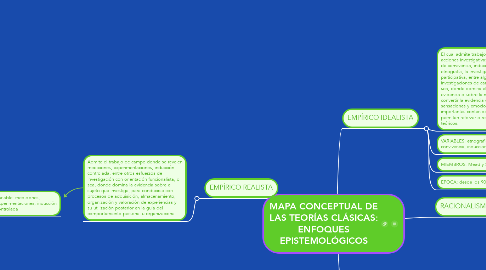
1. EMPÍRICO REALISTA
1.1. Admite el trabajo de campo donde se revelen mediciones, experimentaciones, inducción controlada, entre otros esfuerzos de investigación con orientación funcionalista, o sea, donde domina la evidencia sobre el sujeto que investiga, para conducirse con procesos de adquisición, almacenamiento, organización y valoración de experiencias y su utilización posterior en la guía del comportamiento personal u organizacional.
2. Variable: mediciones, experimentaciones, inducción controlada
3. MIEMBROS: Galileo y Skinner.
4. TEORÍAS: Moulines
5. EPOCA: 1920 Aproximadamente
6. EMPÍRICO IDEALISTA
6.1. El cual admite trabajo de campo, con acciones investigativas tales como, diseños de convivencia, inducción reflexiva, la etnografía, la investigación-acción participativa, entre algunas otras investigaciones de carácter estructuralista, o sea, donde domina el sujeto sobre la evidencia o sobre la misma teoría, para convertir la evidencia en imágenes, sensaciones y emociones, como los más importantes contenidos de la conciencia que permitan reforzar o reconstruir constructos teóricos.
6.2. VARIABLES: etnografía, diseños de convivencia, inducción reflexiva.
6.3. MIEMBROS: Mead y Schutz.
6.4. EPOCA: desde los 90´s
7. RACIONALISMO IDEALISTA
7.1. El cual no necesariamente debería cubrirse trabajo de campo, permitiendo como fundamento de este enfoque, las expresiones vivencial, interpretativas, reflexivitas de la teoría crítica, la neo-dialéctica, así como todo lo que se oriente bajo la concepción del constructivismo, es decir, el reforzamiento de constructos teóricos o conocimientos que ya se poseen.
7.1.1. Situational Analysis / Drivers
7.1.1.1. What is driving us to do this?
7.1.1.2. SWOT Analysis
7.1.1.2.1. Strengths
7.1.1.2.2. Weaknesses
7.1.1.2.3. Opportunities
7.1.1.2.4. Threats
7.1.1.3. Customer Findings - What have we learned from customers?
7.1.2. Competitive Analysis
7.1.2.1. Do we have competitors and threats in these target markets with the proposed offerings?
7.1.2.2. What are our competitors doing and how are they positioning?
7.1.2.3. How do we position against each competitor?
7.1.3. Target Customer(s)
7.1.3.1. Buyer Profile
7.1.3.1.1. Title
7.1.3.1.2. Industry
7.1.3.1.3. Geography
7.1.3.1.4. Business Size
7.1.3.2. Influencer Profile
7.1.3.3. User Profile
7.1.3.4. What do customers want and need?
7.1.3.5. What business problems do each of these customers have?
7.1.4. Customer Segmentation
7.1.4.1. Which customers or sets of customers do we sell to?
7.1.4.2. What are the target market segments that we want to go after?
7.1.4.3. What are the distinct problems for each segment of the market?
7.1.5. Total Available Market
7.1.5.1. New Prospects
7.1.5.1.1. How much of each target segment have we penetrated?
7.1.5.1.2. How much opportunity is available in each target segment?
7.1.5.2. Existing Customers
7.1.5.2.1. Can we up-sell existing customers?
7.2. VARIABLES: Interpretaciones libres, lenguajes amplios, argumentación reflexiva
7.2.1. Service Offer
7.2.1.1. What are we selling?
7.2.1.2. Product Definition
7.2.1.3. Pricing
7.2.1.4. Packaging
7.2.1.5. Positioning
7.2.2. Value Proposition
7.2.2.1. What is the Value Proposition to the Customer?
7.2.2.2. What pain are we solving?
7.3. MIEMBROS: Habermas y Adorno.
7.3.1. Revenue Forecasts
7.3.1.1. Revenue and P&L Forecast (5 Years)
7.3.1.2. Revenue should be split out quarterly
7.3.2. Cost Analysis
7.3.2.1. Should include a description of the costs in entering this business and profitability analysis
7.3.3. Profitability Analysis
7.3.3.1. P&L for the offer to include gross margin, net income and break even analysis.
7.4. EPOCA: Desde los 90´S
7.4.1. M&A?
7.4.2. Risk Analysis & Mitigation
